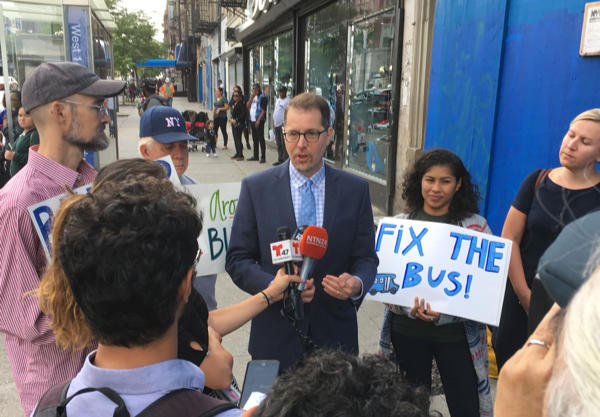Council Members Push DOT and the MTA to Pick Up the Pace on Transit Signal Priority

City Council members are putting some muscle behind the effort to get DOT and the MTA to speed bus service.
At a press conference this morning, Upper Manhattan rep Mark Levine announced legislation that would require DOT to accelerate the implementation of transit signal priority, which reduces the amount of time that buses spend immobilized at traffic lights.
City buses sit at red lights approximately 20 percent of the time. On the five MTA bus routes that currently have TSP (which is usually packaged with other bus priority treatments), travel times improved by an average of 18 percent after implementation, according to DOT.
All city traffic signals are currently TSP-ready, and all MTA buses will soon have the necessary technology. But right now, DOT only plans to install TSP on 10 additional lines by the end of 2020.
Levine and council transportation chair Ydanis Rodriguez want to mandate TSP on “at least” 10 bus routes a year over the next four years.
“Millions who rely on buses are suffering because of slower speeds and longer travel times,” Levine said this morning, standing at a Bx19 stop on 145th Street and Broadway with members of the Bus Turnaround Coalition. “Unlike the subway system, major pieces of bus infrastructure are controlled by the city.”

Over 31,000 people take the Bx19 every day. During the morning rush, the Bx19 moves at an average speed of 4.9 mph, making it the slowest route in the Bronx, said Levine, and a good candidate for TSP.
“End to end this line is six miles,” Levine told Streetsblog after the press conference. “If we’re meeting the scheduled time it’s an hour and a half. On a slow day it’s two hours. You can get Amtrak from New York to Philly in less time than that.”
Levine said people are abandoning the Bx19 — annual ridership dropped from 10.2 million in 2015 to 9.5 million in 2016 — in favor of car trips, either in taxis or private vehicles. “That’s only congesting the streets further,” he said. “It’s only slowing down this line further. That’s going to push more people off the line. It’s a vicious cycle which we’ve got to stop.”
Unlike physical improvements that tend to draw motorist and NIMBY opposition, Levine said there’s “absolutely no political pushback” to giving buses priority at traffic lights. With the technology already in place, the only expense is staff hours devoted to planning and implementing TSP routes.
“This is crying out for rapid rollout,” said Levine, “and we want to push the pace.”
Levine said he hopes to have a bill introduced in the next few weeks.





